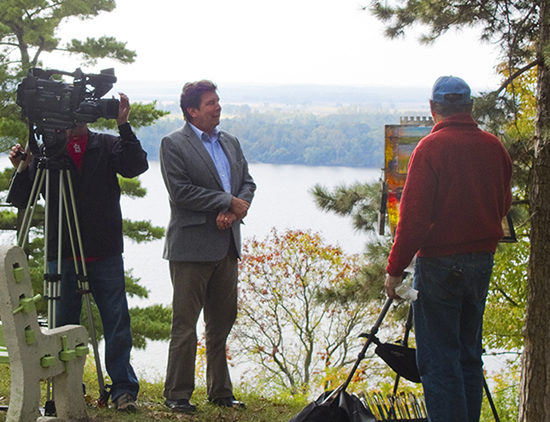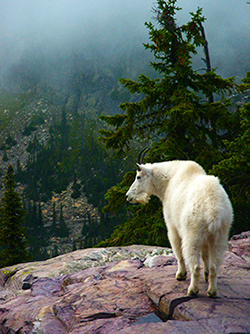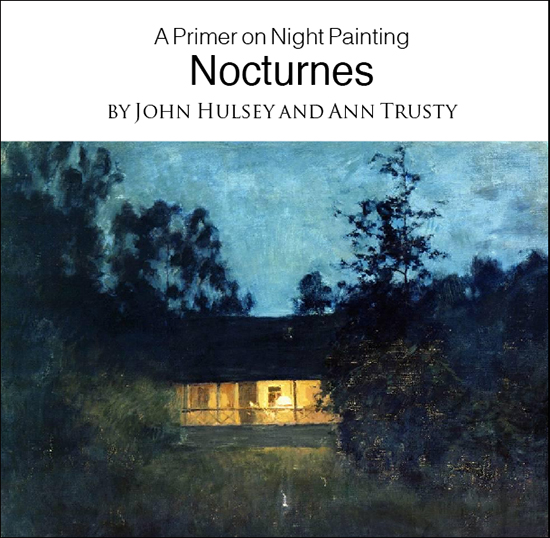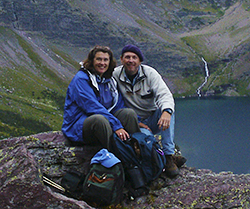A Painting Trip to the Lowcountry, for workshop onlyA Painting Trip to the Lowcountry: Charleston, South Carolina 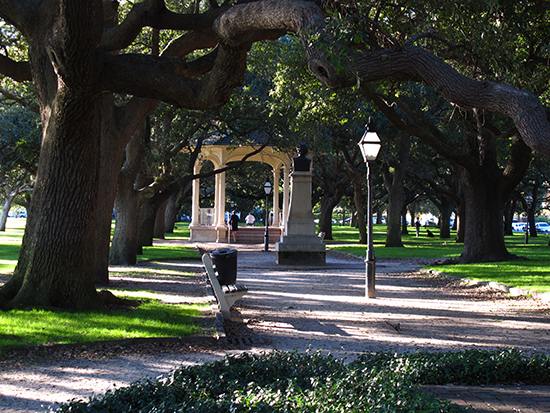 Photograph of Battery Park We have been travelling to Charleston, South Carolina since 1985 to paint, exhibit our work and enjoy the food and hospitality of the South. We were originally drawn to the area because of its sleepy, undiscovered wealth of charms, both architectural and landscape, and would travel there from our home at that time in the Hudson Valley. While in no way is it Florida-warm in the winter, the climate at that time of year is quite pleasant compared to frigid New York, allowing for comfortable outdoor painting. Among the scenic opportunities are a human-scaled downtown filled with antebellum houses and old commercial buildings often with courtyards or gardens, cobblestone streets, a thriving port, pristine beaches, marshes and estuaries. Wildlife is abundant in these natural areas, and each year Charleston hosts the Southeastern Wildlife Exposition, the largest wildlife art/nature event in the nation. Since our first visits, Charleston has been discovered in a big way, and has grown as a result. Over the years, it has also become a significant art center, especially for representational works, and boasts dozens of galleries in downtown alone. Although there are many more tourists evident now, a great many opt to see the town from the vantage point of one of the many horse-drawn carriage tours, which not only adds to the charm but keeps the streets generally uncrowded. Outside of the market and gallery area, the old residential streets are often quiet and serene, making for good places to paint undisturbed.  Battery Park watercolor 5 x 7" John Hulsey The city is located at the confluence of the Ashley and Cooper Rivers, which flow together into Charleston Harbor and the Atlantic Ocean. In its early history, the settlement of Charles Towne faced periodic attacks from both Spain and France, each contesting England’s claim to the area. It later became a focal point in the American Revolution. After South Carolina declared its independence from Britain, Charles Towne twice became the target of British attacks. The British retained control until December of 1782, after which the name was changed to Charleston. In 1860, South Carolina became the first state to secede from the Union and cadets from the Citadel, in Charleston, fired the first shots of the Civil War against a Union ship entering Charleston harbor. Natural disasters have also caused significant destruction to Charleston and the region. In 1866 Charleston was nearly destroyed by an earthquake measuring 7.5. In 1989, Hurricane Hugo caused over 2.8 billion dollars of damage to the area. One of the great pleasures for me while painting in Charleston is the curiosity and interest shown by passers-by. Invariably friendly and complimentary, Charlestonians are rightly proud of their city and appreciate the notice that artists also take of its features. I suspect that the presence of so many fine galleries there has had the additional effect of offering the population a great contemporary art education and an appreciation for plein air work, much like we often find in Santa Fe. More than once offers were made to buy my just finished plein air studies. That kind of feedback is rare these days, and encourages one to do a good job of it. 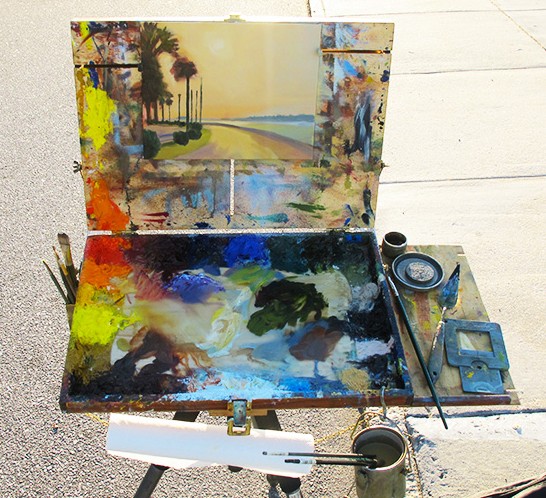 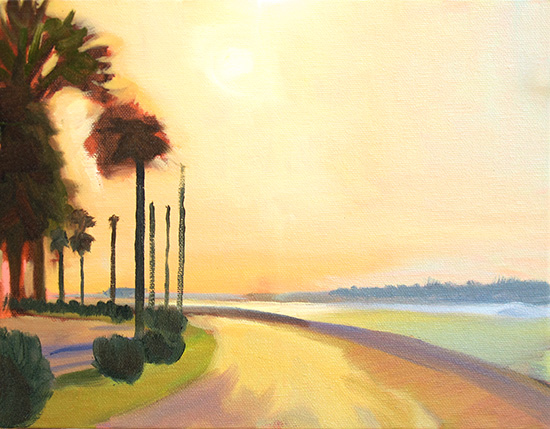
My Open Box M pochade set-up
Blocking in
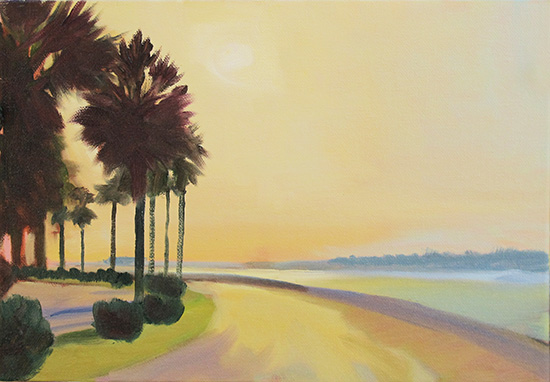 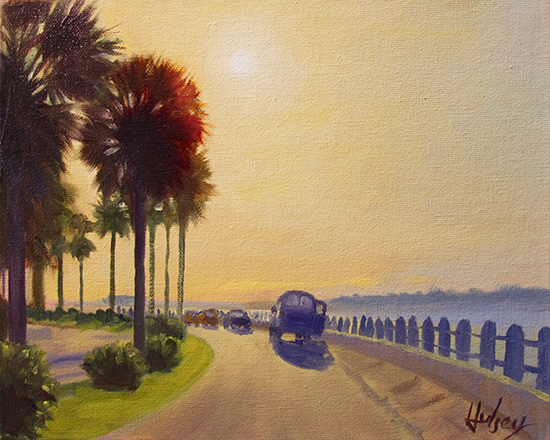 Making adjustments The finish The next day I headed out to paint in the neighborhoods just north of the Battery, an affluent area filled with grand antebellum houses and interesting little alleys and side streets. In the style of the period and occupying narrow, but deep lots, many of these fine old houses do not face the street, but rather face a side yard, usually a garden, often with a fountain and majestic old trees. Quite a few also have two-tiered columned white porches which face the garden to take advantage of breezes and the shade afforded by those old live oaks. Peering through the ubiquitous, but beautifully crafted iron fences and ornate gates, one is delighted by the luxuriously planted garden landscapes which are filled with warm-climate plants and trees. Palmetto and Sago palms, magnolias, crape myrtles, dogwoods and azaleas abound along with roses and camellias blooming in November! They are inspiration for the winter-hardened painter. 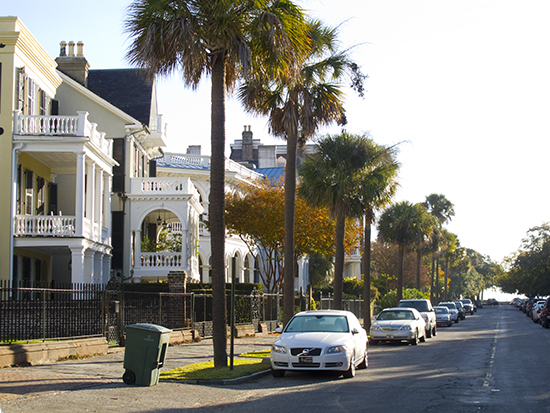 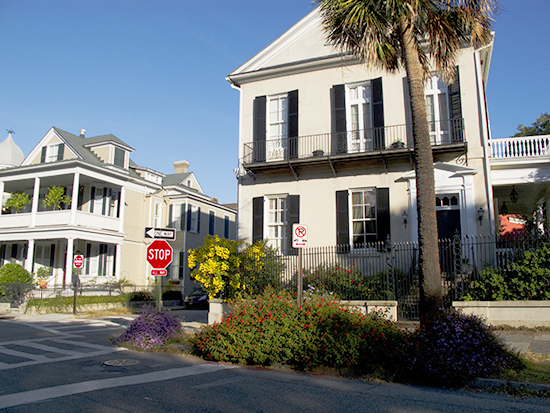 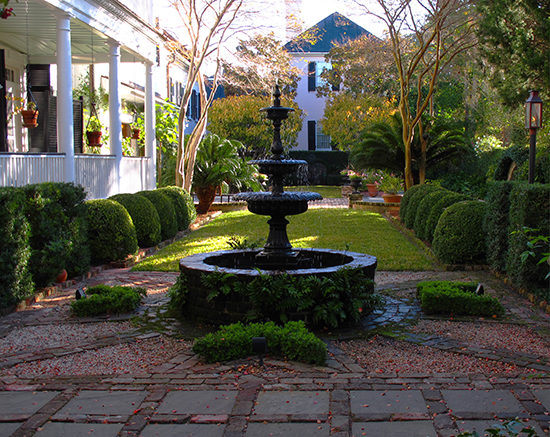 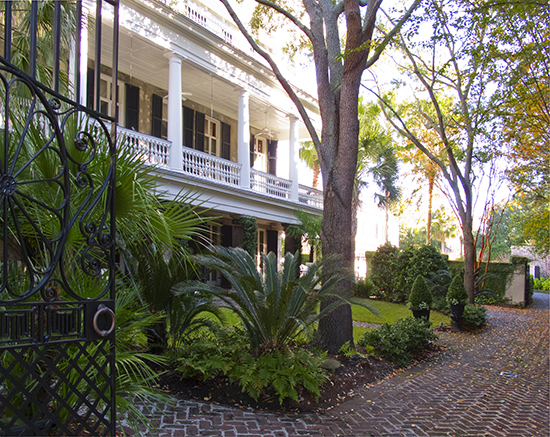 The architecture of
many of these old houses still evidences the original hand-carved or
hand-wrought wood, stone and iron decorations. The artistry of the
iron-work is truly spectacular, and I found myself fascinated by the
play of light on those old gates and fences and the shadows they cast on
the pavement. 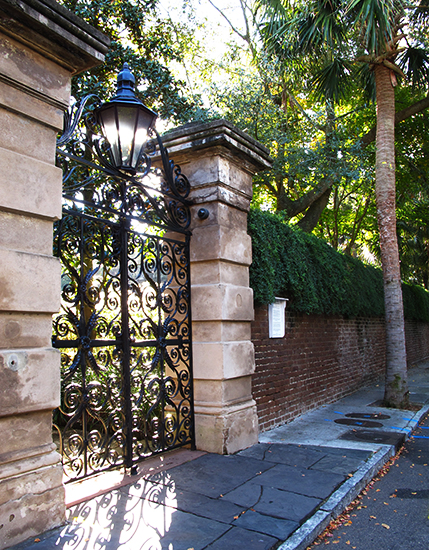 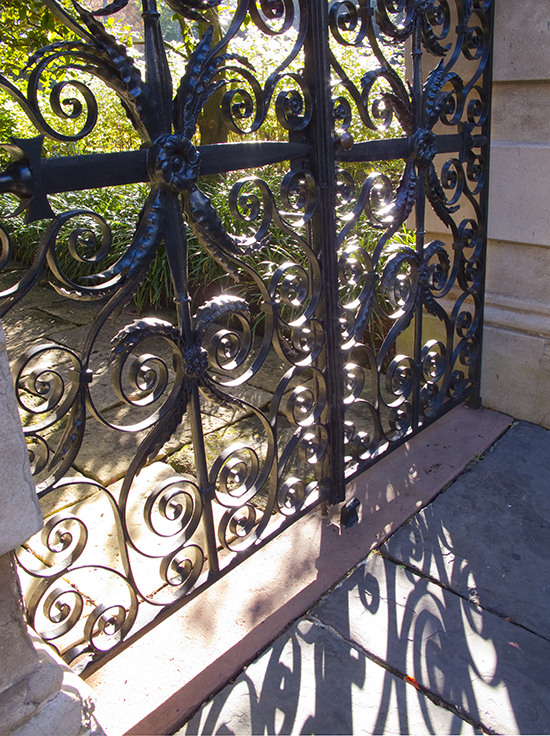 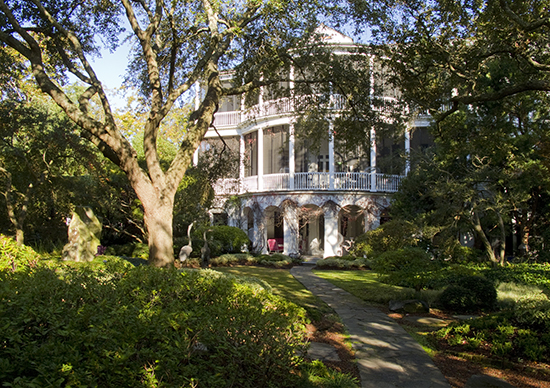 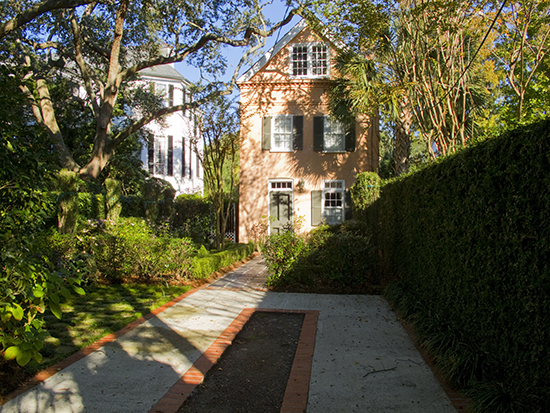 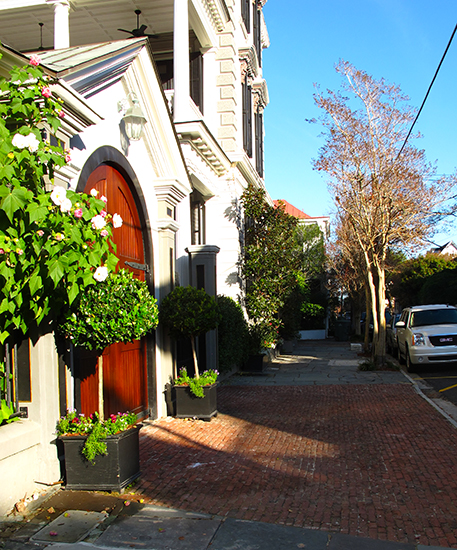 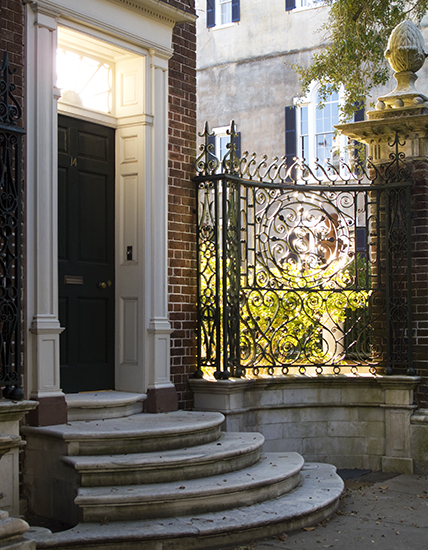 It is easy to spend an entire morning just wandering around these old neighborhoods and marvelling at the beautiful houses, gardens and light streaming through the yards. The painter must allow plenty of time for scouting. I had to resist the temptation this morning to keep strolling and so I set up on Legare Street to paint the light on a beautiful old antebellum-era house, gate and the live oaks which framed it. It took me awhile to get started in the damp 35-degree air, but the street was quiet, the light superb and the picture seemed to paint itself as the morning warmed. 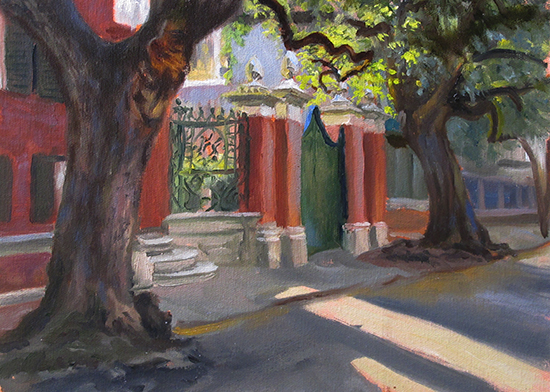 Legare Street Study, oil, 9 x 12" John Hulsey The following morning I walked down to one of the carriage companies near to where we were staying and asked if I might be able to paint there. I was fascinated by the whole operation, and quickly realized that the heart of that business is the care of these large animals, first and foremost. The business of carriage tours must come second, so the early morning is filled with a bustle of well-organized activity getting more than a dozen animals ready for the day. I set up my gear just outside the large double doors on the north side of the main barn/stable where I could paint a team of mules which was already dressed and hitched as they waited for the carriage to fill up. Blue light washed over the warm browns of their coats and faded into the darks of the barn interior. The leather tack and shiny hardware of their dressings was also interesting and helped define the shapes of the animals. 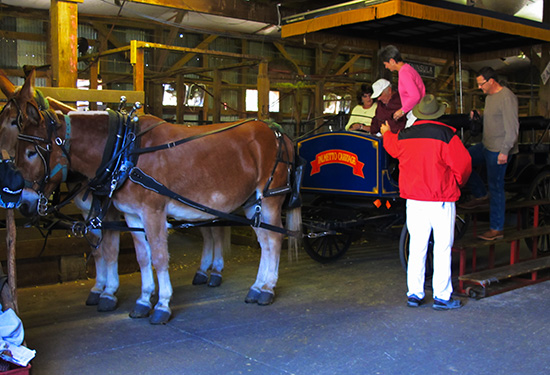 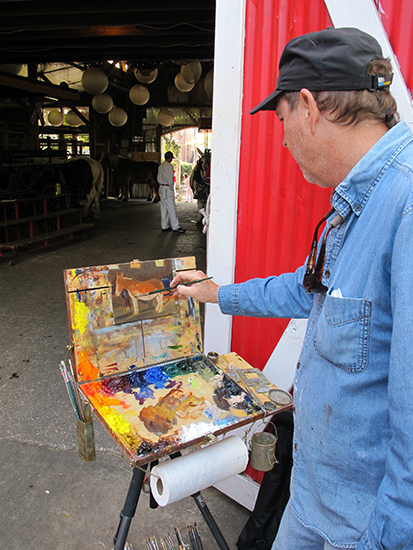 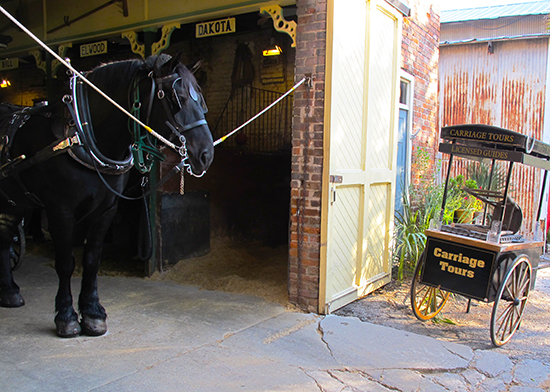 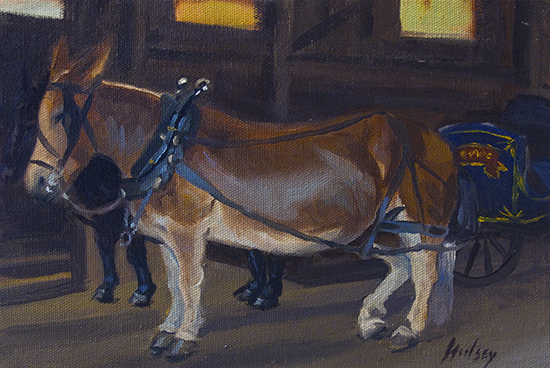 I was forced to work efficiently from the start, as the mules would have to pull out as soon as the carriage was full. Each time another pair of mules pulled a loaded carriage from the interior of the barn near my location, they veered over and gave me a wide-eyed once-over. I think that they were as curious about me as I was of them. I finished my little study in the nick of time just as my subjects pulled their loaded wagon out of the barn, swerved toward me and then away. Charleston also offers the visual stimulation of a diversity of boats, ships and water scenes. There are numerous marinas scattered around the harbor which are full of every conceivable type of pleasure boat. The U.S.S. Yorktown aircraft carrier is permanently docked on the Cooper River next to the Patriot’s Point Naval and Maritime Museum, along with a submarine and destroyer. Fleets of sailboats can often be seen on the Cooper as well, near the U.S.S. Yorktown, and the contrast of the little white sails against the immense grey bulk of the carrier is interesting. I prefer painting the working boats and commercial ships which ply the waters of the harbor. This trip I focused on the pilot boats used to deliver and retrieve the pilots who bring the big ships safely into the harbor, and on the shrimp boats which are docked across the river at Shem Creek, in Mt. Pleasant. 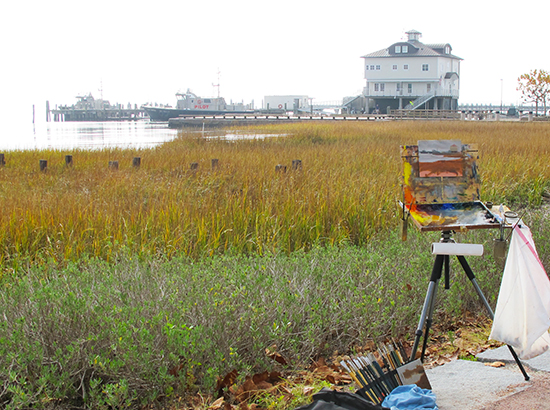 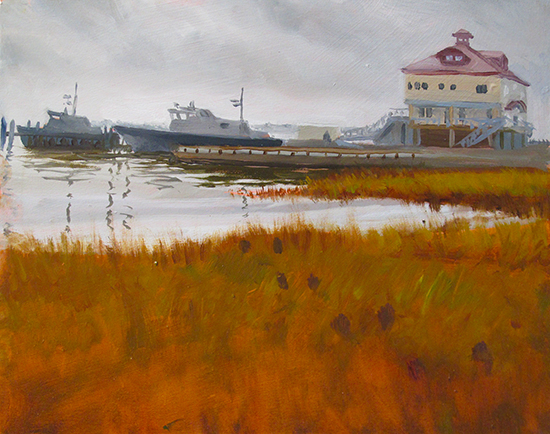 My set-up at the waterfront Pilot Boats in Fog, oil study, 9 x 12, John Hulsey On two separate foggy mornings I made studies of the pilot boats and docks, and the following week I made my way over to Shem Creek, in Mt. Pleasant, to rendezvous with 4 other painter friends who had driven down to Charleston from Tennessee for an Oil Painters of America "paint-out". 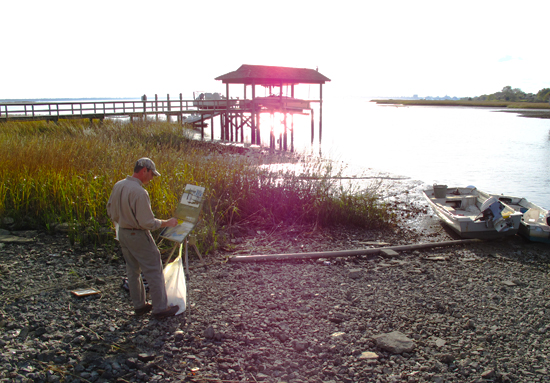 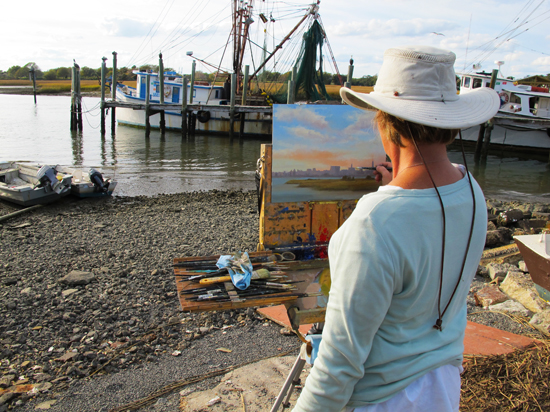 Kevin Menck painting at Shem Creek Beverly Ford Evans The area around Shem Creek is full of painting subjects so I returned again another day to paint the work boats in the lovely, but dazzling afternoon light. Many picture opportunities exist in these interesting locations, from the ocean-stained fishing boats with their tall masts and dangling nets to the shacks and warehouses sitting on ruined pilings. Light dances up from the water and creates a wonderful calligraphy on the hulls of the boats and the metal-sided buildings. I think an entire exhibition could be produced just from the subject matter around Shem Creek. For those of us who love to paint the ocean and the beaches, the Charleston area offers superb opportunities. One of the main public accesses to the beach is on Isle of Palms. It can be reached by crossing the impressive new Ravenel suspension bridge over the Cooper River and proceeding through Mount Pleasant on Route 17, then taking the Connecter to Isle of Palms and the beach. Because of their orientation, the beaches there provide both sunrise and sunset painting opportunities. 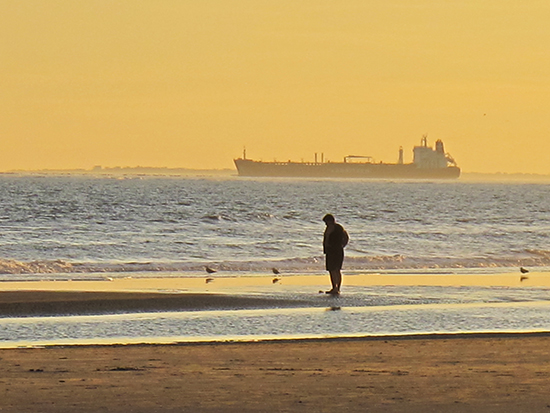 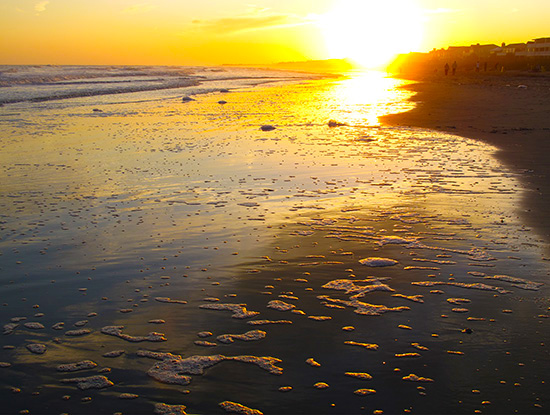 Beachcomber, Isle of Palms Sunset, Isle of Palms I have often painted on the Isle of Palms beaches, and they never fail to provide inspiration, especially at or near sunrise and sunset. The wet sand is a remarkable mirror of the sky at those moments and I am always fascinated by the abstract patterns produced. If you prefer solitude, the sun often rises over a peaceful beach empty of people but alive with wildlife of all kinds. I often work in oil there, but have had good results working in pastel also. 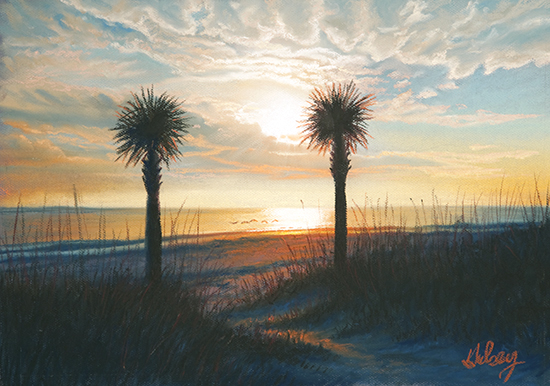 Morning Walk pastel John Hulsey 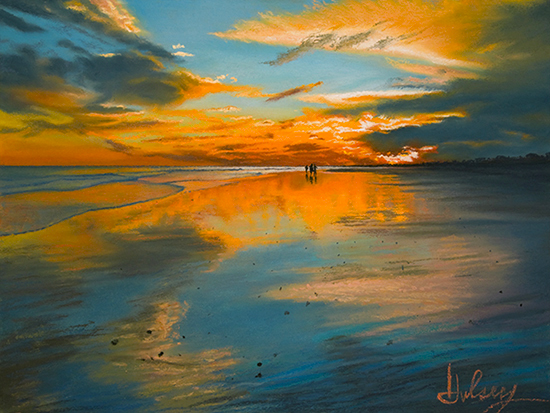 Tramonto pastel John Hulsey If one is looking for a more natural beach environment, then we suggest making the trek south to Hunting Island State Park. Hunting Island is a wild place, where the trees meet the water and one can get a sense of what the undeveloped coastline must have been like. It is worth the trip, and on the way back, one can buy fresh-caught shrimp right off the boats. |
Become an Artist's Road Member Today!
Already a Member?Log in here. To renew your membership, log in and follow the links. Search the SitePerspectivesNot ready to become a Member yet? Subscribe to our free email postcards, "Perspectives". Enter your email address here.
Member ContentFree ContentThe Artist's Road StoreNocturnes - A Primer on Night Painting Filled with inspirational examples by the masters of nightime painting, this little book is sure to fire up your creative energies. Never tried painting at night? We show you how it's done with a step-by-step-oil demo and a tale of night painting in the wilds of Rocky Mountain National Park. The Primer on Night Painting - Nocturnes is a 7 x 7" PDF download with 40 pages of text and images. It includes a gallery of paintings by masters of the nocturne, information to inspire and encourage you in your plein air nocturne painting, an illustrated step-by-step demo and tips for working in pastel and oil. Also available in a softcover edition. Check out the tools and other products that we use in our own art and travels in The Artist's Road Store. We only offer things for sale that we enthusiastically believe in.
About Us
|
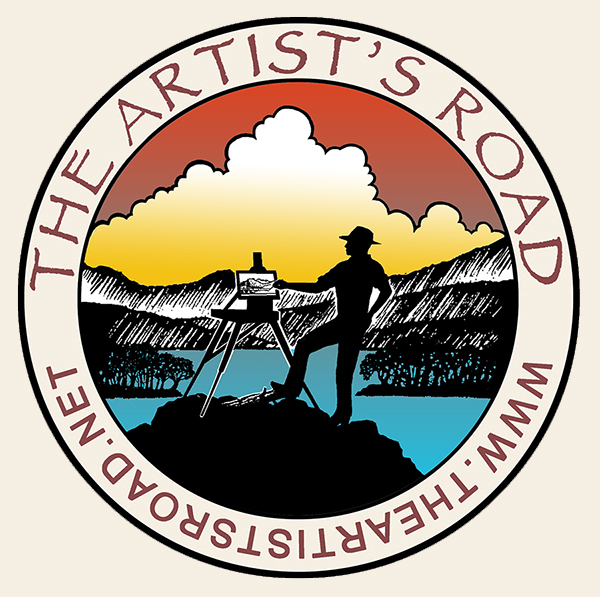
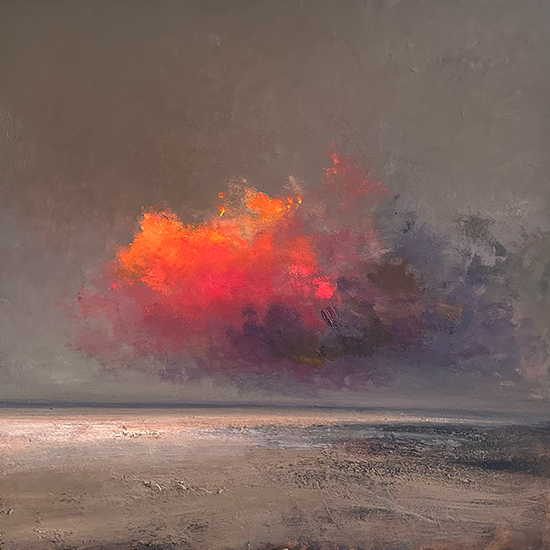 Voices of Experience:Richard K. Blades
Voices of Experience:Richard K. Blades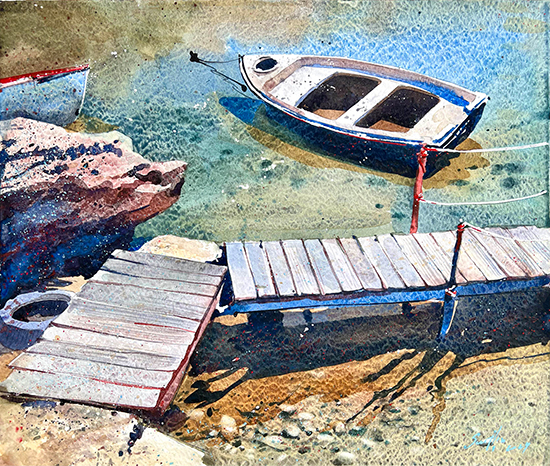
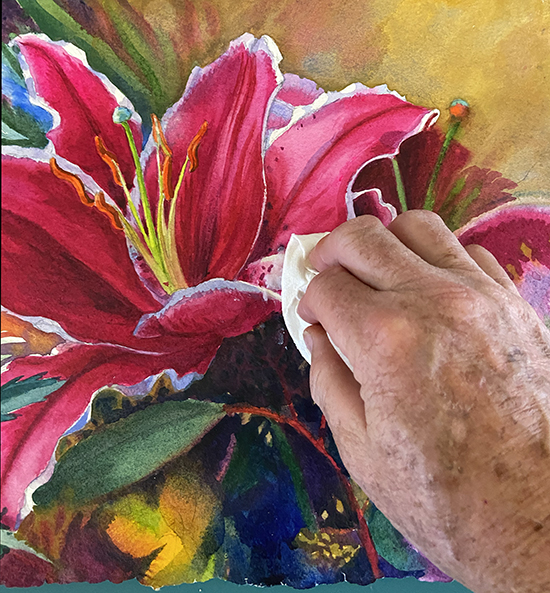 ing Watercolors
ing Watercolors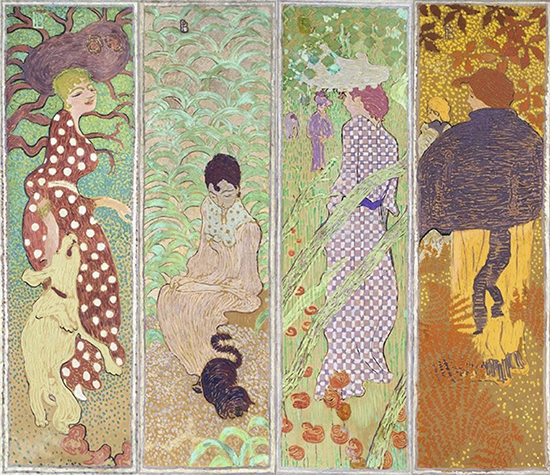
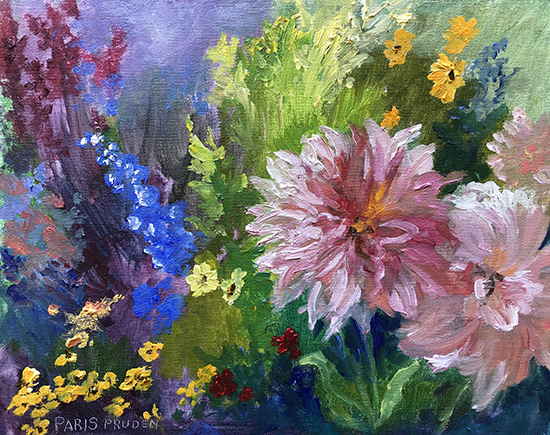
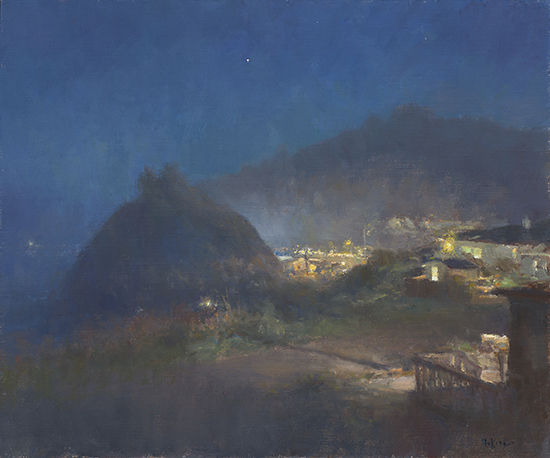 Nocturne Notes
Nocturne Notes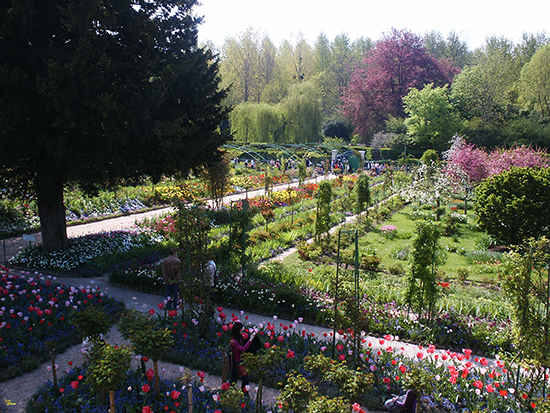 Inspiration in Monet's Gardens
Inspiration in Monet's Gardens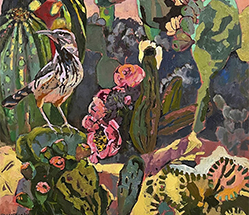
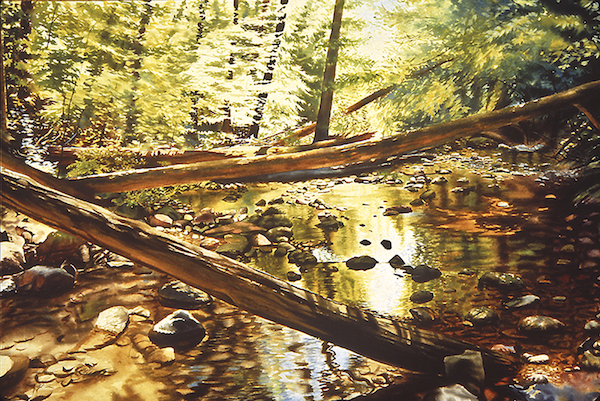 The Watercolor Medium
The Watercolor Medium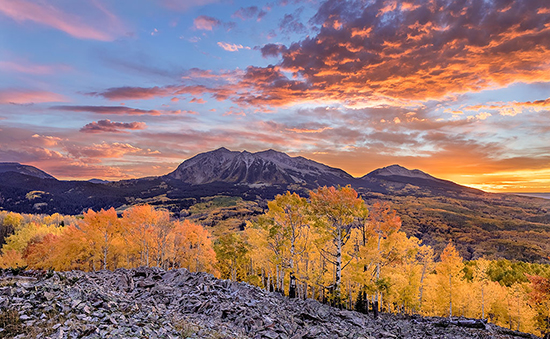
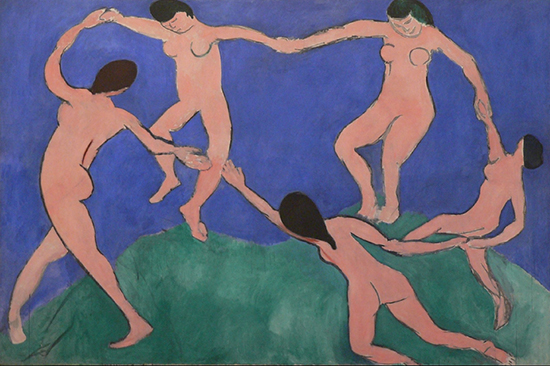 The Perspectives Archive
The Perspectives Archive